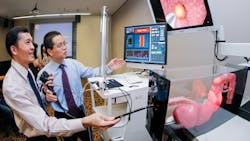Real-time in vivo molecular diagnostic system diagnoses precancerous tissues during endoscopy
A team of researchers from the National University of Singapore (NUS), led by associate professor Huang Zhiwei of the Department of Biomedical Engineering, has developed an in vivo molecular diagnostic system clinically proven for diagnosing precancerous tissue in the gastrointestinal tract during endoscopic examination in real time.
Related: Multiphoton endoscopy for clinical applications
Related: Three-mode endoscopy for ovarian cancer detection
Unlike conventional endoscopic techniques that rely on doctors’ eyeball interpretation of the images followed by pathologists’ analysis of the biopsy specimen several days later, the research team's diagnostic system utilizes computer analysis of biomolecular information to enable objective diagnosis of cancer in real time.
The system has been used in more than 500 patients in Singapore with stomach, esophageal, colon, rectum, head and neck, and cervical cancers. The researchers have also published their work in more than 40 peer-reviewed publications--their most recent in the January 2014 issue of Gastroenterology. They have also filed two U.S. and two UK patents for their invention.
Moving forward, Huang says that the team will be conducting clinical trials on a larger scale to further validate the clinical utility of their system, particularly in gastrointestinal cancers.
-----
Follow us on Twitter, 'like' us on Facebook, and join our group on LinkedIn
Subscribe now to BioOptics World magazine; it's free!

